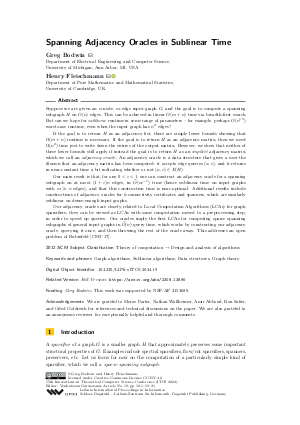@InProceedings{bodwin_et_al:LIPIcs.ITCS.2024.19,
author = {Bodwin, Greg and Fleischmann, Henry},
title = {{Spanning Adjacency Oracles in Sublinear Time}},
booktitle = {15th Innovations in Theoretical Computer Science Conference (ITCS 2024)},
pages = {19:1--19:21},
series = {Leibniz International Proceedings in Informatics (LIPIcs)},
ISBN = {978-3-95977-309-6},
ISSN = {1868-8969},
year = {2024},
volume = {287},
editor = {Guruswami, Venkatesan},
publisher = {Schloss Dagstuhl -- Leibniz-Zentrum f{\"u}r Informatik},
address = {Dagstuhl, Germany},
URL = {https://drops.dagstuhl.de/entities/document/10.4230/LIPIcs.ITCS.2024.19},
URN = {urn:nbn:de:0030-drops-195475},
doi = {10.4230/LIPIcs.ITCS.2024.19},
annote = {Keywords: Graph algorithms, Sublinear algorithms, Data structures, Graph theory}
}

 Creative Commons Attribution 4.0 International license
Creative Commons Attribution 4.0 International license




























